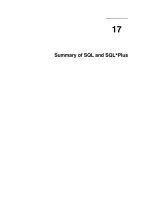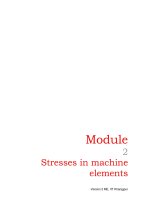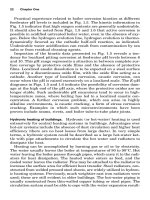Tài liệu Implementation of the Asthma Practice Guideline in the Army Medical Department - Evaluation of Process and Effects pdf
Bạn đang xem bản rút gọn của tài liệu. Xem và tải ngay bản đầy đủ của tài liệu tại đây (1.21 MB, 212 trang )
This document and trademark(s) contained herein are protected by law
as indicated in a notice appearing later in this work. This electronic
representation of RAND intellectual property is provided for non-
commercial use only. Permission is required from RAND to reproduce, or
reuse in another form, any of our research documents.
Limited Electronic Distribution Rights
Visit RAND at www.rand.org
Explore RAND Arroyo Center
View document details
For More Information
This PDF document was made available
from www.rand.org as a public service of
the RAND Corporation.
6
Jump down to document
THE ARTS
CHILD POLICY
CIVIL JUSTICE
EDUCATION
ENERGY AND ENVIRONMENT
HEALTH AND HEALTH CARE
INTERNATIONAL AFFAIRS
NATIONAL SECURITY
POPULATION AND AGING
PUBLIC SAFETY
SCIENCE AND TECHNOLOGY
SUBSTANCE ABUSE
TERRORISM AND
HOMELAND SECURITY
TRANSPORTATION AND
INFRASTRUCTURE
WORKFORCE AND WORKPLACE
The RAND Corporation is a nonprofit
research organization providing
objective analysis and effective
solutions that address the challenges
facing the public and private sectors
around the world.
Purchase this document
Browse Books & Publications
Make a charitable contribution
Support RAND
This product is part of the RAND Corporation monograph series.
RAND monographs present major research findings that address the
challenges facing the public and private sectors. All RAND mono-
graphs undergo rigorous peer review to ensure high standards for
research quality and objectivity.
Prepared for the United States Army
Approved for public release; distribution unlimited
Evaluation of Process and Effects
Implementation
of the Asthma
Practice Guideline
in the Army Medical
Department
Donna O. Farley
Shan Cretin
Georges Vernez
Suzanne Pieklik
Elaine Quiter
J. Scott Ashwood
Wenli Tu
The RAND Corporation is a nonprofit research organization providing
objective analysis and effective solutions that address the challenges
facing the public and private sectors around the world. RAND’s
publications do not necessarily reflect the opinions of its research clients
and sponsors.
R
®
is a registered trademark.
© Copyright 2005 RAND Corporation
All rights reserved. No part of this book may be reproduced in any
form by any electronic or mechanical means (including photocopying,
recording, or information storage and retrieval) without permission in
writing from RAND.
Published 2005 by the RAND Corporation
1776 Main Street, P.O. Box 2138, Santa Monica, CA 90407-2138
1200 South Hayes Street, Arlington, VA 22202-5050
201 North Craig Street, Suite 202, Pittsburgh, PA 15213-1516
RAND URL: />To order RAND documents or to obtain additional information, contact
Distribution Services: Telephone: (310) 451-7002;
Fax: (310) 451-6915; Email:
Library of Congress Cataloging-in-Publication Data
Implementation of the asthma practice guideline in the Army Medical Department :
evaluation of process and effects / Donna O. Farley [et al.].
p. cm.
Includes bibliographical references.
“MG-319.”
ISBN 0-8330-3773-0 (pbk.)
1. United States. Army—Medical care. 2. Asthma—Treatment—United States.
I. Farley, Donna.
UH523.I47 2005
616.2'3806—dc22
2005006111
The research described in this report was sponsored by the United States
Army under Contract No. DASW01-01-C-0003.
iii
Preface
The RAND Corporation has worked with the Army Medical
Department (AMEDD) on a project entitled “Implementing Clinical
Practice Guidelines in the Army Medical System.” This project was
undertaken to assist the AMEDD in developing and testing methods
to effectively implement clinical practice guidelines in Army treat-
ment facilities, with the goal to achieve consistent and quality clinical
practices across the Army health system. Three demonstrations were
conducted to test and refine methods before embarking on full
guideline implementation across the Army health system. These
demonstrations tested use of guidelines for primary care management
of low back pain, asthma, and diabetes.
This report presents the final findings from the evaluation that
RAND conducted as part of the demonstration for the asthma prac-
tice guideline, which was conducted in 1999 and 2000. The assess-
ment included a process evaluation of the experiences of the
participating military treatment facilities (MTFs) as well as a quanti-
tative analysis of clinical practices. The quantitative analysis was per-
formed to document the extent to which intended actions were
actually implemented by the MTFs, assess short-term effects on clini-
cal practices, and develop and test metrics and measurement methods
that can be adopted by the AMEDD for routine monitoring of pro-
gress.
We present the findings from the process evaluation and the
quantitative analysis to provide as complete a picture as possible of
baseline variations in practices across facilities, changes in clinical
iv Implementation of the Asthma Practice Guideline in AMEDD
practices made by the demonstration sites, and measurable effects of
these actions. We also present diagnostic information on the quality
and limitations of available data for monitoring practice improve-
ments. Recommendations for future actions by the AMEDD are pre-
sented.
This report is one of three final reports being generated in this
project. It should be of interest to anyone concerned with military
medical systems and policies. Similar reports were prepared from the
demonstrations for the low back pain and diabetes practice guide-
lines.
This research was sponsored by the U.S. Army Surgeon General.
It was conducted jointly by RAND Arroyo Center, a federally funded
research and development center sponsored by the U.S. Army, and by
the RAND Center for Military Health Policy Research.
For more information on the RAND Arroyo Center, contact the
Director of Operations, (310) 393-0411, extension 6500, or visit the
Arroyo Center’s Web site at />v
Contents
Preface iii
Figures
ix
Tables
xi
Summary
xv
Acknowledgments
xxxi
Abbreviations
xxxiii
CHAPTER ONE
Introduction 1
Overview of the Military Health System
2
The DoD/VA Guideline Adaptation Process
3
The AMEDD-RAND Guideline Implementation Project
4
Overview of the Asthma Practice Guideline
5
A Systems Approach to Implementation
7
Basic Implementation Strategy
8
Six Critical Success Factors for Implementation
9
The AMEDD Guideline Implementation Process
11
The Demonstration Sites
13
The RAND Evaluation
15
Organization of This Report
15
CHAPTER TWO
Methods and Data 17
Process Evaluation Methods
18
Climate Survey
19
vi Implementation of the Asthma Practice Guideline in AMEDD
Evaluation Site Visits 20
Monthly Reports
22
Outcome Evaluation
22
Hypotheses for Effects of Implementation of the Asthma
Guideline
23
Evaluation Design
24
Choice of Demonstration and Control Sites
24
The Asthma Population
25
Data Sources
28
Outcome Measures
29
Definition of Key Variables
29
Analytic Methods
29
Estimating the Costs of Care
31
CHAPTER THREE
Asthma Populations and Practices at the Baseline 35
The Asthma Population Served by Army MTFs
36
Characteristics of the Total Asthma Population
36
Enrollment Status and Use of MTF Services
37
Baseline Performance on Asthma Care Measures at the Study MTFs
42
Summary
49
CHAPTER FOUR
The Guideline Implementation Process 53
MEDCOM Support
54
The Kickoff Conference
54
The Asthma Toolkit
55
Information Exchange
59
Structure and Support at the MTFs
60
The MTF Environment
60
Baseline Climate for Guideline Implementation
61
Support for the Demonstration
63
Implementation Activities and Progress
68
Implementation Strategies
68
The Implementation Process and Activities
72
Lessons Learned
82
Contents vii
MEDCOM Support 82
Support at the MTF
84
CHAPTER FIVE
Effects of Guideline Implementation 85
Provider Knowledge and Acceptance of the Guideline
85
Reported Changes in Clinical Practices
87
Changes in Referral Patterns
87
Changes in Asthma Indicators Monitored by the Sites
88
Changes in Asthma Medication Prescriptions
88
Analysis of Effects on Service Delivery
89
The Study Sample
89
Measures and Methods
89
Use of Long-Term Controller Medications
91
Use of Short-Acting Rescue Medications for Asthma Exacerbations
92
Use of Outpatient Services
93
Use of Emergency Room Services
95
Use of Hospital Inpatient Services
97
Estimated Costs of Care
98
Overall Costs of MTF Services
101
Variations in Costs Across Facilities
104
Summary
107
CHAPTER SIX
Synthesis of Findings from the Demonstration 109
Findings on the Implementation Process
109
Implementing the Guideline Practices
109
Six Critical Success Factors
110
Effects of Implementing Practice Improvements
113
Outcome Measures
113
Potential Contributing Factors
114
Costs
116
Data Issues
116
Recommendations
117
viii Implementation of the Asthma Practice Guideline in AMEDD
APPENDIX
A. Hypotheses for Effects of Improved Asthma Care Practices 123
B. Evaluation Methodology
125
C. Modules of the Climate Survey
153
D. Physician Questionnaire
161
E. Analyses of Asthma Metrics
169
Bibliography
173
ix
Figures
1.1. Diagram of the Demonstration Project 5
1.2. Matrix of Implementation Outcomes
9
1.3. Guideline Implementation Process
12
2.1. Evaluation Timeline
25
3.1. Enrollment Status of Asthma Patients for Outpatient and
Emergency Room Visits to MTF and Network Providers,
by Study Year
40
3.2. Enrollment Status of Asthma Patients for Inpatient Admissions
at MTFs and Network Providers, by Study Year
41
3.3. Outpatient and Emergency Room Visits to MTFs and Network
Providers, by Enrollment Status of Asthma Patients and
Study Year
42
3.4. Inpatient Admissions at MTFs and Network Providers, by
Enrollment Status of Asthma Patients and Study Year
43
3.5. Baseline Percentage of Asthma Patients Prescribed Long-Term
Controller Medications, Total and by Site
45
3.6. Baseline Percentage of Asthma Patients Prescribed
Complementary Medications, Total and by Site
46
3.7. Baseline Percentage of Asthma Patients Prescribed Short-Acting
Rescue Medications, Total and by Site
47
3.8. Baseline Annual Asthma-Related Outpatient Visits per 100
Asthma Patients, Total and by Site
48
3.9. Baseline Annual Asthma-Related Emergency Room Visits
per 100 Asthma Patients, Total and by Site
49
x Implementation of the Asthma Practice Guideline in AMEDD
3.10. Baseline Annual Asthma-Related Hospitalizations per 100
Asthma Patients, Total and by Site
50
5.1. Prescription of Long-Term Controllers, for Target
Demonstration, Other Demonstration, and Control Sites,
by Year
92
5.2. Prescription of Complementary Medications, for Target
Demonstration, Other Demonstration, and Control Sites,
by Year
93
5.3. Prescription of Short-Acting Rescue Medications, for Target
Demonstration, Other Demonstration, and Control Sites,
by Year
94
5.4. Trends in Asthma-Related Outpatient Visit Rates, by Target
Demonstration, Other Demonstration, and Control Sites
95
5.5. Trends in Asthma-Related Emergency Room Visit Rates,
by Target Demonstration, Other Demonstration, and
Control Sites
96
5.6. Trends in Asthma-Related Hospital Inpatient Stays, by Target
Demonstration, Other Demonstration, and Control Sites
98
5.7. Composition of MTF Total Costs for Asthma Patients Who
Were MTR Enrollees and Nonenrolled Users for
Demonstration and Control Sites, by Study Year
99
5.8. Estimated Total MTF Cost per Asthma Patient for MTF
Enrollees and Other Users of the Demonstration and Control
Sites, by Study Year
100
B.1. A System View of Guideline Implementation
125
xi
Tables
S.1. Asthma Indicators and Associated Hypotheses xix
1.1. Key Elements of the DoD/VA Asthma Practice Guidelines
6
1.2. Profiles of the MTFs Participating in the Asthma Guideline
Demonstration
14
1.3. Activities of the MTFs Participating in the Asthma Guideline
Demonstration
15
2.1. Expected Effects of Proactive Asthma Care Management
24
2.2. Asthma Patient Sample Sizes for the Demonstration and Control
MTFs, by Study Year
27
2.3. Source of Data for Analyses
28
2.4. Indicators Used to Measure Effects on Clinical Practices
Related to Implementation of the DoD/VA Asthma Practice
Guideline
30
3.1. Identification of the Asthma Population Served by Army
MTFs or Network Providers in Army MTF Catchment Areas,
by Study Year
37
3.2. Demographic Characteristics of the Asthma Population Served
by Army MTFs or Network Providers in Army MTF
Catchment Areas, by Study Year
38
3.3. Enrollment Status for Patients Receiving Asthma Care at Army
MTFs or Network Providers in Army MTF Catchment Areas,
by Study Year
39
3.4. Asthma Population Using the Demonstration and Control
MTFs, by Study Year
44
3.5. Rationale for Asthma Indicators Provided by the Guideline
45
xii Implementation of the Asthma Practice Guideline in AMEDD
4.1. Contents of the Asthma Toolkit 56
4.2. Baseline Survey Scores on Quality Improvement, MTF Climate,
and Attitudes Toward Practice Guidelines
62
4.3. Baseline Motivation for Guideline Implementation by the
Implementation Teams
63
4.4. Asthma Metrics Initially Selected by the Demonstration
Sites
69
5.1. Number and Percentage of Asthma Patients Enrolled in
TRICARE Prime at a Demonstration or Control MTF (MTF
Enrollees), by MTF
90
5.2. Estimated MTF Costs for Asthma Patients Who Were MTF
Enrollees at the Demonstration and Control MTFs, Study
Years One and Two
102
5.3. Estimated MTF Costs for Nonenrollee Asthma Patients Using
Care at the Demonstration and Control MTFs, Study Years
One and Two
104
5.4. Estimated Costs of Outpatient, Inpatient, and Total Services
for Asthma Patient MTF Enrollees at the Demonstration
Sites, Study Years One and Two
105
5.5. Estimated Costs of Outpatient, Inpatient, and Total Services
for Asthma Patient MTF Enrollees at the Control Sites, Study
Years One and Two
106
B.1. Dimensions Addressed by the Process Evaluation
126
B.2. Dimensions Addressed by the Process Evaluation and Data
Collection Methods
127
E.1. Percentage of Asthma Patients Prescribed Long-Term Controller
Medications for Target Demonstration, Other Demonstration,
and Control Groups, by Year
169
E.2. Percentage of Asthma Patients Prescribed Complementary
Medications for Target Demonstration, Other Demonstration,
and Control Groups, by Year
169
E.3. Percentage of Asthma Patients Prescribed Short-Acting Rescue
Medications for Target Demonstration, Other Demonstration,
and Control Groups, by Year
170
Contents xiii
E.4. Average Annualized Asthma-Related Outpatient Visit Rates per
100 Asthma Patients for Target Demonstration, Other
Demonstration, and Control Groups, by Quarter
170
E.5. Average Annualized Asthma-Related Emergency Room Visit
Rates per 100 Asthma Patients for Target Demonstration, Other
Demonstration, and Control Groups, by Quarter
170
E.6. Average Annualized Asthma-Related Hospitalization Rates per
100 Asthma Patients for Target Demonstration, Other
Demonstration, and Control Groups, by Quarter
171
xv
Summary
The Army Medical Department (AMEDD) has made a commitment
to establishing a structure and process to support its military treat-
ment facilities (MTFs) in implementing evidence-based practice
guidelines with the goal of achieving best practices that reduce varia-
tion and enhance quality of medical care. The Quality Management
Directorate of the Army Medical Command (MEDCOM) con-
tracted with RAND to work as a partner in the development and
testing of guideline implementation methods for ultimate application
to an Army-wide guideline program.
Three practice guideline demonstrations were fielded over a
two-year period, in each of which participating Army MTFs imple-
mented a different clinical practice guideline. All the demonstrations
worked with practice guidelines that were established collaboratively
by the Department of Veterans Affairs (VA) and Department of
Defense (DoD).
This report presents results from our evaluation of the second of
the three demonstrations, in which four participating MTFs imple-
mented the asthma practice guideline in AMEDD’s Southeast Region
demonstration.
1
The evaluation included both a process evaluation to
document the implementation activities of participating MTFs, and
an analysis of effects to estimate the extent to which the sites’ imple-
mentation activities affected specific measures of service delivery for
____________
1
The first demonstration was for a low back pain practice guideline, which was imple-
mented at four MTFs in the Great Plains Region. The third was for a diabetes guideline,
which was implemented by two MTFs in the Western Region.
xvi Implementation of the Asthma Practice Guideline in AMEDD
asthma, with comparisons to a group of similar MTFs that did not
implement the guideline. The evaluation also looked at the effects of
the implementation on MTF costs.
Overview of the Military Health System
The Army operates a health system with more than 40 MTFs across
the country and overseas that provide health care to military person-
nel, their family members, and retirees. This system has a regional
structure led by the Army Surgeon General and MEDCOM. The
MTFs range from small community hospitals to large regional medi-
cal centers offering tertiary services, which provide both ambulatory
care and inpatient services.
Separate from the military health care system is its health insur-
ance program, called TRICARE, that covers health benefits for eligi-
ble military personnel, family members, and retirees. To augment the
MTF services, TRICARE contracts with local community providers
in the civilian sector to provide covered services. This insurance pro-
gram has a managed-care option called TRICARE Prime. All active-
duty personnel are automatically enrolled in TRICARE Prime and
are assigned to an MTF-based primary care manager (PCM), which
serves as a gatekeeper for all care. Military family members and some
retirees also have the option of enrolling in TRICARE Prime, in
which case they can choose either an MTF-based physician or a
community provider for their PCM. Those who are eligible for
TRICARE but choose not to enroll in TRICARE Prime are auto-
matically enrolled in another TRICARE option through which they
can decide where to receive care on a case-by-case basis.
The Asthma Practice Guideline
The principal emphasis of the DoD/VA practice guideline for pri-
mary care management of asthma is on effective management of
asthma, including medication management, with the goal of pre-
Summary xvii
venting exacerbations that require treatment interventions. The
guideline has four key elements: initial asthma diagnosis; asthma
management procedures to classify asthma severity, treat based on
severity, provide preventive maintenance, and educate patients on
self-care; emergency management of asthma exacerbations; and tele-
phone triage to assess severity of exacerbation and review the action
plan with the patient.
Implementation of the Guideline
Four MTFs in the Southeast Regional Medical Command served as
demonstration sites for implementation of the asthma guideline:
Eisenhower Army Medical Center (AMC) at Fort Gordon, Georgia;
Blanchfield Army Community Hospital (ACH) at Fort Campbell,
Kentucky; Martin ACH at Fort Benning, Georgia; and Moncrief
ACH at Fort Jackson, South Carolina. These four MTFs represented
diverse patient populations, facility sizes, and service mixes. In pre-
paring for implementation, MTF commanders designated a “guide-
line champion” at each facility to lead the implementation process, a
facilitator to coordinate the MTF’s implementation activities, and an
implementation team with representatives from the various clinical
groups involved in asthma care.
A systems approach was applied in the AMEDD practice guide-
line implementation demonstrations. This approach sought to ensure
successful practice change in MTFs by addressing two main dimen-
sions: building local ownership or “buy-in” from the staff responsible
for implementing the new practices and ensuring that clinical and
administrative systems are in place to facilitate staff adherence to the
guideline.
The asthma guideline was introduced in September 1999. To
prepare for implementation, MEDCOM held a kickoff conference to
introduce the implementation teams from participating MTFs to the
practice guideline and to provide monitoring metrics and a toolkit of
materials to support the MTFs’ implementation activities. At the
conference, MTF teams developed action plans for implementing the
xviii Implementation of the Asthma Practice Guideline in AMEDD
guideline. After the conference, each MTF team began to implement
activities it defined in its plan. Although the MTFs varied in how
quickly they started implementation, all of them were pursuing their
planned actions by January 2000.
The RAND Evaluation
The evaluation of the asthma practice guideline demonstration con-
sisted of both a process evaluation and an analysis of the effects of the
guideline on service utilization.
Process Evaluation. We took a formative approach to the pro-
cess evaluation in which we learned from the MTFs’ experiences,
provided feedback to the MTFs and MEDCOM, and facilitated
shared learning among the MTFs. To gather evaluation information,
we used a “climate survey” conducted during the kickoff conference;
interviews, focus groups, and surveys, which were conducted during
two evaluation site visits
2
; and monthly progress reports prepared by
participating MTFs.
Effects Analysis. The analysis of the effects of the guideline on
service utilization used a time-series, comparison-group design to
estimate effects of the demonstration on six indicators of care that
could be measured using available administrative data. These mea-
sures and associated hypotheses are shown in Table S.1.
We compared measures for baseline performance (one year
before introduction of the asthma guideline, January through Decem-
ber 1999) and performance at one year following introduction (Janu-
ary through December 2000) for the four demonstration sites and six
control sites. We estimated MTF costs of care for asthma patients and
assessed how costs changed with guideline implementation.
Each MTF provides asthma care not only to patients enrolled
with a PCM at its facility but also to patients enrolled in TRICARE
____________
2
The first site visits took place in February and March 2000. The second site visits took
place in September 2000.
Summary xix
Table S.1
Asthma Indicators and Associated Hypotheses
Indicator Hypothesis
Long-term controllers Increase in percentage of asthma patients using long-
term controllers (inhaled corticosteroid, leukotriene
inhibitor, Beta
2
agonist/CS, or oral corticosteroid)
Complementary mainte-
nance medications
Increase in percentage of asthma patients using
complementary maintenance medications (Beta
2
agonist/LA or methylxanthine)
Short-acting rescue medi-
cations
Increase in percentage of asthma patients using short-
acting rescue medications (Beta
2
agonist)
Outpatient visits Decrease in asthma-related outpatient visit rate per
1,000 asthma patients
Emergency room visits Decrease in asthma-related emergency room visit rate
per 1,000 asthma patients
Hospitalization Decrease in asthma-related hospitalization rate per
1,000 asthma patients
Prime with a PCM located elsewhere and others who have chosen the
more open TRICARE coverage option. Recognizing this variety of
patients, three patient groups were considered in the evaluation of
guideline effects: the entire population of TRICARE-eligible asthma
patients treated by Army MTFs or who resided in Army MTF
catchment areas and were served by network providers, all asthma
patients who used one of the demonstration or control MTFs for
inpatient or outpatient services at least once during a year (MTF
users), and asthma patients who are enrolled in TRICARE Prime and
have a PCM at one of the demonstration or control MTFs (MTF
enrollees), who are a subset of the MTF users.
The patient group used as the sample for assessing effects of
asthma guideline implementation was the MTF enrollees at the dem-
onstration and control MTFs. The distinction between the MTF
enrollees and other patients served is important for this study. For
patients with such chronic diseases as asthma, MTF-based PCMs
have the span of control to manage care for the patients who are
enrolled with them. However, MTFs have much less ability to man-
age care for patients they only see intermittently.
xx Implementation of the Asthma Practice Guideline in AMEDD
Baseline Performance on Key Performance Measures
We first characterized the total population of asthma patients (those
who used an Army MTF or resided in an Army MTF catchment area
in the continental United States) during the two-year study period.
3
An estimated 121,500 asthma patients were served during the first of
our two study years and an estimated 121,000 patients were served
during the second study year. This population consists primarily of
Army family members, individuals affiliated with other military ser-
vices, and family members of retirees. Patients are fairly evenly dis-
tributed across age groups. The asthma populations served by the
individual MTFs vary widely in size, reflecting differences in the sizes
and characteristics of the beneficiary populations residing in their
catchment areas.
In examining data for demonstration and control MTFs, we dis-
tinguished between MTF enrollees and MTF users. Although the
majority of asthma-related outpatient or emergency room visits were
for MTF enrollees (patients who were enrolled in TRICARE at the
MTF that provided their care), a substantial portion of patients seen
were other MTF users (enrolled at other MTFs or civilian network
sites). By contrast, the MTFs’ own enrollees accounted for virtually
all asthma-related inpatient care provided by these MTFs.
The baseline comparisons of outcome measures for the study
sites show that many of the indicators varied only moderately across
the MTFs at baseline. For the three medication indicators, in par-
ticular, MTFs had similar percentages of patients using each type of
medication. For some service-use indicators, such as emergency room
care and hospitalization, one or two MTFs had either much higher or
much lower levels than the other MTFs in the sample. However, the
importance of these differences depends on how the actual perfor-
mance at each site varies from recommended guidelines, where appli-
cable.
____________
3
This population was defined using International Classification of Diseases, Ninth Revision
(ICD-9), diagnosis codes in administrative data.
Summary xxi
Lessons from the Process Evaluation
Performance on the Critical Success Factors
Research on practice guideline implementation has documented that
a commitment to the implementation process, including use of mul-
tiple interventions, is required to achieve desired changes to clinical
practices. Drawing on this literature as well as the experiences
observed in the earlier AMEDD low back pain guideline demonstra-
tion, we identified six critical factors that influence how successful an
MTF will be in integrating new practices into its clinical and admin-
istrative processes. We assess here the extent to which MTFs in this
demonstration realized these success factors, which in turn affected
their progress in implementing practice improvements.
• Command leadership commitment at the MTF, regional,
and system levels. Management leaders at all three levels of
AMEDD influence how front-line personnel perceive what pri-
ority the system places on the use of practice guidelines.
This demonstration had somewhat more positive support from
the leadership of the participating MTFs than had been provided in
the low back pain demonstration, but attitudes by regional and
system-level leadership still were mixed. In the MTFs, the command
team supported the implementation teams as they instituted the
guideline, but this support generally was passive and MTF com-
manders did not exert full ownership locally.
• Monitoring of progress. Both the local MTFs and MEDCOM
have roles in monitoring the quality of health care practices
according to evidence-based standards defined in practice guide-
lines and roles in providing feedback needed for effective per-
formance improvement.
The monitoring activities in the demonstration had a mixed
track record. The focus of the demonstration MTFs was on using
medical chart data to document the extent to which the new clinical
xxii Implementation of the Asthma Practice Guideline in AMEDD
practices they had introduced were in fact being used—e.g., to
document asthma severity in the chart. Such a focus helps to ensure
that these practices are becoming an integral part of clinic processes as
intended. Other than the analysis performed in this evaluation,
MEDCOM did not monitor asthma metrics during the demonstra-
tion but relied on data generated by the MTFs.
• Guidance and support to the MTFs by MEDCOM. The
structured approach and toolkits of supportive materials pro-
vided are resources that support the MTFs as they carry out
actions to improve clinical practices.
By the time the asthma guideline demonstration began,
MEDCOM had expanded its staffing and other resources, and we
observed its staff providing regular policy guidance and technical
support to help the MTF teams implement practice improvements
for asthma care. During the site visits, the implementation teams at
the demonstration MTFs reported this committed MEDCOM sup-
port was helpful to them and they were pleased to have it.
• Guideline champions who are opinion leaders. There is
extensive evidence of the importance of having a designated
clinical leader to serve as champion for the practice improve-
ments being pursued.
The participating MTFs identified well-respected physicians to
serve as guideline champions for the asthma demonstration, and these
physicians showed a commitment to leading the implementation
activities for their facilities. However, the champions could only make
a time-limited commitment to the initiative, after which they tired of
the concentrated effort or had to turn their attention to other priori-
ties.
• Resource support for champions. To serve effectively as a
guideline champion, the designated champion needs to be given
adequate dedicated time and other resource support. This sup-
Summary xxiii
port also signals that the MTF command places a priority on
guideline implementation.
The MTF commanders did not provide tangible resource sup-
port for the activities of the guideline champions, other than for
attendance at the kickoff conference. As a result, the champions per-
formed the implementation work in addition to their regular work-
load, which contributed to their reluctance to sustain the champion
role. Facilitators designated by the MTF commander provided some
staff support for the champions, a role that was part of the facilitators’
regular responsibilities because they worked in the MTF quality man-
agement offices. The delayed implementation of the MTF action
plans stemmed in part from competing demands on the champions’
time.
• Institutionalization of new practices. For sustainability, the
new practices being introduced need to be integrated into the
standard practices of the facility as quickly as possible.
At the time of the last process evaluation site visit, the partici-
pating MTFs had made progress in introducing improved asthma
management practices in some of their primary care clinics, but they
had not yet achieved sustainable practices in those clinics. None had
yet begun to extend the new practices into other clinics serving
asthma patients that had not participated in the demonstration.
In summary, we observed reasonably good performance on some
of the success factors in this demonstration. The most noticeable
positive items were the MTF efforts to monitor their progress in
implementing the intended practice changes and selection of effective
champions. MEDCOM also was able to provide responsive support
for the asthma demonstration. It appears that lessons learned from
the earlier low back pain demonstration contributed to these man-
agement results (see Farley, Vernez, et al., 2003). Although the par-
ticipating MTFs identified effective champions, the champions were
not given dedicated time to help them perform their additional roles.
Competing demands on champions’ time weakened the teams’









